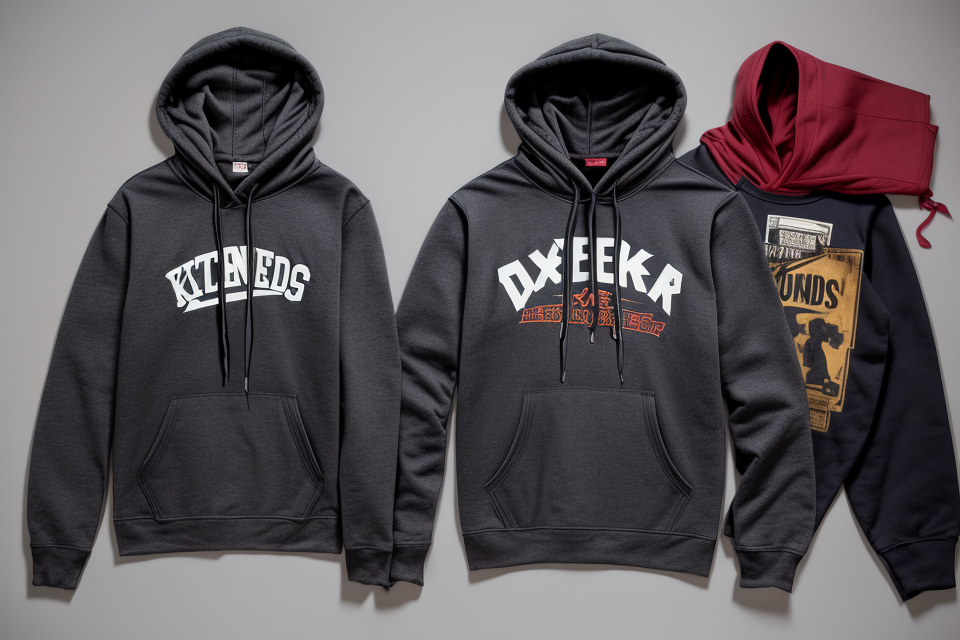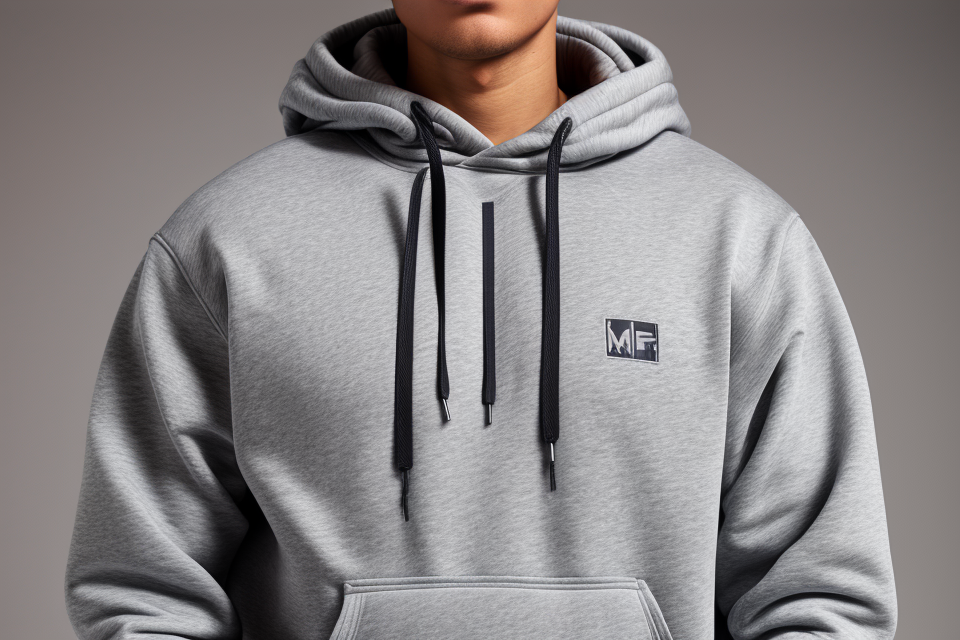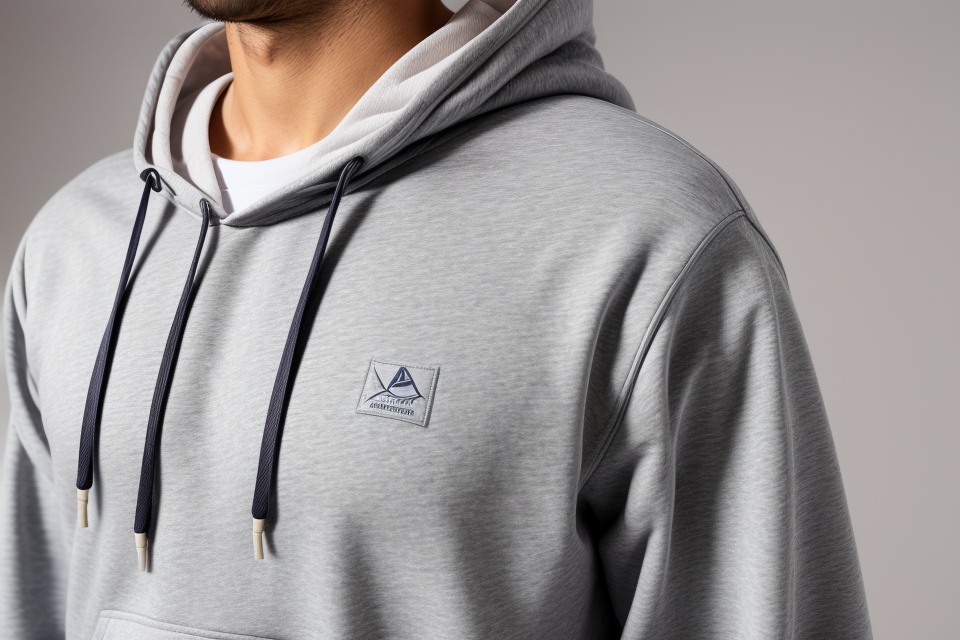
Hoodies are a wardrobe staple for many of us, but unfortunately, they don’t always last as long as we’d like them to. However, there are several expert tips that can help you make your hoodie last longer. From taking care of the fabric to choosing the right materials, these tips will help you extend the life of your hoodie and keep it looking great for years to come. So, if you want to learn how to make your hoodie last longer, read on for our top 10 expert tips.
What Makes a Hoodie Durable?
Material and Quality
Finding the Right Fabric
Choosing the right fabric for your hoodie is crucial in determining its durability. When selecting a fabric, consider the following factors:
Natural vs Synthetic Materials
- Natural materials, such as cotton and wool, are generally softer and more breathable than synthetic materials like polyester and nylon. However, natural materials are also more prone to wrinkling and may not be as durable as synthetic materials in the long run.
- Synthetic materials, on the other hand, are known for their strength and resistance to wrinkles. They are also often more water-resistant than natural materials. However, some synthetic materials can be less comfortable against the skin than natural materials.
Understanding Material Weight
- The weight of a fabric refers to its thickness and density. A heavier fabric will generally be more durable and insulating than a lighter fabric. However, it may also be less breathable and more prone to wrinkling.
- When choosing a fabric for your hoodie, consider the intended use and the climate in which you will be wearing it. A heavier fabric may be more suitable for colder weather or for outdoor activities, while a lighter fabric may be more appropriate for everyday wear or for warmer climates.
Choosing High-Quality Brands
- Investing in high-quality brands can make a significant difference in the durability of your hoodie. Brands that use high-quality materials and construction techniques are more likely to produce garments that will last longer and withstand wear and tear better.
- When shopping for a hoodie, look for brands that are known for their quality and durability. Do some research to find out which brands are highly rated by experts and customers alike.
- Pay attention to the stitching and construction of the hoodie. High-quality brands will use reinforced stitching in high-stress areas, such as the shoulders and neckline, to increase the lifespan of the garment.
By considering these factors when choosing a hoodie, you can ensure that your hoodie will last longer and provide you with more wear over time.
Proper Care and Maintenance
Washing Your Hoodie
Washing your hoodie is an essential part of its care and maintenance. It is important to wash it regularly to keep it clean and fresh. Here are some tips for washing your hoodie:
Tips for Machine Washing
- Use cold water: Machine washing your hoodie in cold water can help prevent shrinkage and damage to the fabric.
- Use a gentle cycle: Choose a gentle cycle on your washing machine to avoid agitating the hoodie too much, which can cause damage to the fabric.
- Avoid overloading the washing machine: Do not overload the washing machine as this can cause the hoodie to become misshapen and may cause damage to the fabric.
- Use a lint filter: Use a lint filter in your washing machine to prevent the hoodie from getting caught on the fibers and becoming damaged.
Hand Washing Guide
- Use a mild detergent: Use a mild detergent when hand washing your hoodie to avoid damaging the fabric.
- Avoid agitating the hoodie: Avoid agitating the hoodie too much while washing it, as this can cause damage to the fabric.
- Rinse thoroughly: Rinse the hoodie thoroughly to remove all soap and detergent residue.
- Use cold water: Use cold water when rinsing the hoodie to prevent shrinkage and damage to the fabric.
Drying Your Hoodie
Drying your hoodie is an essential part of its care and maintenance. It is important to dry it properly to prevent shrinkage and damage to the fabric. Here are some tips for drying your hoodie:
Best Practices for Drying
- Air dry: Air drying your hoodie is the best way to prevent shrinkage and damage to the fabric.
- Do not overload the dryer: Do not overload the dryer as this can cause the hoodie to become misshapen and may cause damage to the fabric.
- Remove from dryer immediately: Remove the hoodie from the dryer immediately to prevent it from becoming overheated and damaged.
Common Mistakes to Avoid
- Using high heat: Avoid using high heat when drying your hoodie, as this can cause shrinkage and damage to the fabric.
- Overloading the dryer: Avoid overloading the dryer, as this can cause the hoodie to become misshapen and may cause damage to the fabric.
- Leaving it in the dryer too long: Do not leave the hoodie in the dryer too long, as this can cause it to become overheated and damaged.
Proper Storage and Use
Storing Your Hoodie
Best Storage Methods
When it comes to storing your hoodie, there are several methods that can help keep it in good condition for as long as possible.
Closet Organization Tips
One of the best ways to store your hoodie is to hang it up in your closet. This will keep it off the ground and prevent it from getting wrinkled or stretched out of shape.
To make the most of your closet space, consider investing in a hanging organizer or a set of adjustable shelves. These can help you keep your hoodie organized and easy to access, while also maximizing the space in your closet.
Utilizing Space-Saving Storage Solutions
If you don’t have a lot of closet space, there are still plenty of options for storing your hoodie safely. Consider using a hanging storage bag or a foldable garment bag to keep your hoodie clean and protected.
Alternatively, you can store your hoodie in a dresser drawer or a storage box. Just be sure to fold it properly and avoid cramming it into a small space, as this can cause it to wrinkle or lose its shape.
Caring for Your Hoodie When Not in Use
Tips for Maintaining Shape and Quality
In addition to proper storage, there are several other tips you can follow to keep your hoodie in good condition when not in use.
First, try to avoid washing your hoodie too frequently, as this can cause it to wear down faster. Instead, spot clean any stains as needed and let your hoodie air dry.
You should also avoid exposing your hoodie to excessive heat or direct sunlight, as this can cause it to fade or lose its shape over time. Instead, store it in a cool, dry place where it won’t be exposed to extreme temperatures.
Finally, try to avoid wearing your hoodie for extended periods of time, as this can cause it to stretch out of shape. If you need to wear your hoodie for an extended period, consider taking it off periodically to give it a break and prevent damage.
Repair and Maintenance
Identifying Damage
Common Issues with Hoodies
When it comes to hoodies, there are several common issues that can arise over time. These issues can cause damage to the fabric, reducing the lifespan of your hoodie. It’s important to identify these issues as soon as possible to prevent further damage and ensure that your hoodie lasts longer.
Tears and Holes
Tears and holes are one of the most common issues with hoodies. These can occur due to wear and tear, snags from zippers or buttons, or even from sharp objects. Small tears and holes may not affect the functionality of your hoodie, but larger ones can cause it to wear out faster and look worse for wear.
Wear and Tear
Wear and tear is another common issue with hoodies. This can occur due to regular wear, washing, and drying. Over time, the fabric can become thin and weak, and the seams can start to fray. This can cause your hoodie to lose its shape and fit, and it may start to look discolored or worn out.
Stains
Stains are also a common issue with hoodies. These can occur due to spills, sweat, or even from the environment around you. Stains can be difficult to remove, and if left untreated, they can cause permanent damage to the fabric. It’s important to identify stains as soon as possible and treat them promptly to prevent further damage.
By identifying these common issues with hoodies, you can take the necessary steps to prevent further damage and ensure that your hoodie lasts longer.
Repairing and Upkeep
DIY Repair Solutions
When it comes to repairing and maintaining your hoodie, there are several DIY solutions that you can try at home. These simple fixes can help you extend the life of your hoodie and keep it looking and feeling great.
Simple Fixes for Common Issues
- Lost buttons: If your hoodie has lost some of its buttons, you can easily replace them with new ones. Simply remove the old buttons and sew on new ones in their place.
- Tears or holes: If your hoodie has tears or holes, you can patch them up with fabric patches. Cut out a patch that is slightly larger than the hole or tear, and sew it onto the damaged area.
- Frayed hem or cuffs: If your hoodie’s hem or cuffs are frayed, you can trim them with scissors or use pinking shears to prevent them from fraying further.
When to Call the Professionals
While there are several DIY repair solutions that you can try at home, there are some issues that require the expertise of professionals. If your hoodie has more significant damage, such as a ripped seam or a hole in the fabric, it’s best to take it to a professional repair service.
Preserving Your Hoodie’s Integrity
In addition to repairing any damage, there are several tips that you can follow to preserve your hoodie’s integrity and extend its lifespan.
Tips for Extending the Life of Your Hoodie
- Wash it properly: Wash your hoodie in cold water and avoid using chlorine bleach on protein-based stains such as blood or milk.
- Avoid drying it: Never put your hoodie in the dryer, as it can shrink and lose its shape. Instead, air-dry it or use a low-heat setting in the dryer.
- Store it properly: Fold your hoodie carefully and store it in a cool, dry place. Avoid storing it in direct sunlight or in a damp environment.
By following these simple tips, you can help extend the life of your hoodie and keep it looking and feeling great for years to come.
Upgrading Your Hoodie
Choosing Upgrades Wisely
When it comes to upgrading your hoodie, it’s important to choose upgrades that will not only improve its aesthetic appeal but also its durability and functionality. Here are some tips to help you make the right choices:
Material Upgrades
Understanding Different Types of Fabric
The type of fabric used in your hoodie can greatly affect its durability and performance. For example, cotton is a popular choice for hoodies, but it’s not the best option for extreme conditions. On the other hand, synthetic materials like polyester and nylon are more resistant to water and wear and tear. Before choosing an upgrade, make sure you understand the different types of fabric available and their specific characteristics.
Enhancing Durability with High-Quality Materials
When it comes to material upgrades, it’s essential to invest in high-quality materials that will enhance the durability of your hoodie. For instance, you can upgrade your hoodie’s lining or outer layer with a higher quality fabric that is more resistant to wear and tear. Additionally, consider adding reinforcements to areas that are prone to wear and tear, such as the shoulders and cuffs.
Choosing Insulation for Extreme Conditions
If you plan to use your hoodie in extreme conditions, you may want to consider upgrading its insulation. For example, if you live in a cold climate, you may want to upgrade your hoodie’s insulation to keep you warm in freezing temperatures. There are various types of insulation available, including synthetic and natural materials, each with its own unique benefits. Make sure to choose an insulation that is suitable for the conditions you’ll be using your hoodie in.
Other Upgrades
Choosing High-Quality Zippers and Trims
Upgrading your hoodie’s zippers and trims can greatly improve its appearance and functionality. For example, upgrading to high-quality zippers can make it easier to open and close your hoodie, while upgrading to high-quality trims can enhance its overall aesthetic appeal. When choosing upgrades for your hoodie, make sure to choose high-quality zippers and trims that will last.
Adding Features for Functionality
In addition to improving your hoodie’s appearance, you can also upgrade its functionality by adding features. For example, you can add pockets to your hoodie to store your essentials, or you can add a hood to keep your head and neck warm. When choosing upgrades, make sure to choose features that will enhance your hoodie’s functionality and meet your specific needs.
Staying Comfortable in Your Hoodie
Layering and Climate Control
Understanding Temperature Regulation
When it comes to temperature regulation, hoodies are designed to help keep you warm by trapping air between layers of fabric. This process, known as “dead-air space,” is what helps insulate your body from the cold. Additionally, some hoodies are made with moisture-wicking materials that draw sweat away from your skin, keeping you dry and comfortable.
How Hoodies Regulate Temperature
Hoodies are made with a variety of materials, each with its own unique properties when it comes to temperature regulation. For example, cotton hoodies are good at retaining heat, while synthetic materials like polyester are better at wicking moisture away from the body.
Tips for Optimal Comfort
To stay comfortable in your hoodie, it’s important to understand the role that temperature regulation plays in your overall comfort. Here are a few tips to keep in mind:
- Layer your clothing appropriately. If it’s cold outside, layer your hoodie over a long-sleeved shirt or thermal. If it’s warm, you can still wear a t-shirt underneath your hoodie for an extra layer of warmth.
- Pay attention to the material of your hoodie. If you’re prone to sweating, look for hoodies made with moisture-wicking materials like polyester or nylon.
- Don’t be afraid to remove your hoodie if you get too warm. It’s better to have the option to remove a layer than to be too hot and uncomfortable.
Choosing Appropriate Clothing for the Weather
In addition to understanding how your hoodie regulates temperature, it’s important to choose appropriate clothing for the weather. Here are a few tips to keep in mind:
- Dress in layers. This allows you to easily adjust your clothing based on the temperature.
- Choose moisture-wicking materials. These materials will help keep you dry and comfortable, even if you’re active or prone to sweating.
- Wear appropriate footwear. If you’re going to be outside for an extended period of time, make sure you have comfortable and weather-appropriate shoes or boots.
Staying Dry and Cool
Staying dry and cool is an important part of staying comfortable in your hoodie. Here are a few strategies for staying dry and cool:
- Choose moisture-wicking materials. As mentioned above, these materials will help keep you dry by drawing sweat away from your skin.
- Take breaks to cool down. If you’re prone to overheating, take a break in a cooler location or find a breeze to cool down.
- Use sweat-resistant fabrics. Some fabrics, like mesh or perforated leather, are designed to be sweat-resistant and can help keep you cool in hot weather.
By following these tips, you can make the most of your hoodie and stay comfortable no matter what the weather has in store.
Durability Meets Style
Choosing Timeless Designs
When it comes to making your hoodie last longer, choosing timeless designs is a key factor. Here are some benefits of opting for classic styles and examples of timeless designs to consider.
Benefits of Choosing Classic Styles
Choosing classic styles for your hoodie can provide several benefits, including:
- Increased versatility: Classic styles are often more versatile and can be paired with a wider range of clothing options, making it easier to incorporate them into your wardrobe.
- Timeless appeal: Classic styles never go out of fashion, meaning that your hoodie will remain stylish for years to come.
- Durability: Classic styles are often made with high-quality materials that can withstand the test of time, making them a smart investment for your wardrobe.
Examples of Timeless Designs
Here are some examples of timeless hoodie designs that you may want to consider:
- Solid colors: Neutral colors like black, white, and navy are classic choices that can never go wrong.
- Basic patterns: Striped and plaid patterns are also timeless options that can be easily incorporated into your wardrobe.
- Essential logo hoodies: Classic logo hoodies from brands like Champion, Nike, and Adidas are also timeless choices that can be worn for years to come.
When choosing a timeless design, it’s important to consider your personal style and how the hoodie will fit into your wardrobe. With the right choice, you can make your hoodie last longer and ensure that it remains a staple in your wardrobe for years to come.
Maintaining Your Style
Tips for Keeping Your Hoodie Looking New
- Regularly washing your hoodie in cold water to prevent shrinkage and color fading
- Avoiding harsh chemicals and fabric softeners that can damage the fabric
- Air-drying your hoodie instead of using a dryer to prevent stretching and damage to the material
- Using a lint roller to remove any loose fibers or lint that can damage the fabric
Avoiding Common Style Mistakes
- Avoiding exposing your hoodie to extreme temperatures, as this can cause damage to the fabric
- Avoiding exposing your hoodie to the sun for extended periods of time, as this can cause color fading
- Avoiding wearing your hoodie as a sweatshirt, as this can cause sweat stains and damage to the fabric
- Avoiding wearing your hoodie as a beachwear, as sand and salt can cause damage to the fabric
Properly Sizing Your Hoodie
- Ensuring that your hoodie fits well and is not too tight or too loose, as this can cause damage to the fabric
- Choosing a hoodie that is made of a breathable fabric, such as cotton or polyester, to prevent overheating and damage to the fabric
- Ensuring that your hoodie has a full range of motion, so you can move freely without damaging the fabric
In conclusion, by following these tips for maintaining your style, you can help ensure that your hoodie stays looking new for as long as possible. Regularly washing your hoodie in cold water, avoiding harsh chemicals and fabric softeners, and air-drying your hoodie are all effective ways to keep your hoodie looking new. Additionally, avoiding common style mistakes, such as exposing your hoodie to extreme temperatures or wearing it as a sweatshirt, can help prolong the life of your hoodie. Finally, properly sizing your hoodie and choosing a breathable fabric can also help ensure that your hoodie stays in good condition for as long as possible.
FAQs
1. What is the best way to wash my hoodie to make it last longer?
Answer:
One of the most important things you can do to make your hoodie last longer is to wash it properly. Avoid using harsh detergents or fabric softeners, as these can weaken the fabric and cause it to wear out faster. Instead, use a gentle detergent and rinse your hoodie thoroughly before washing it. You should also avoid overloading your washing machine, as this can put too much stress on the fabric and cause it to wear out faster. Finally, consider air-drying your hoodie instead of using a dryer, as this can help prevent shrinkage and wear and tear.
2. How often should I wash my hoodie?
The frequency of washing your hoodie will depend on how often you wear it and how dirty it gets. As a general rule, you should wash your hoodie when it becomes noticeably dirty or smelly. If you wear your hoodie frequently, you may need to wash it every few weeks. However, if you only wear it occasionally, you may be able to get away with washing it less frequently. It’s important to avoid washing your hoodie too often, as this can cause the fabric to weaken and wear out faster.
3. Can I machine wash my hoodie?
It’s generally safe to machine wash your hoodie, but it’s important to follow the care instructions on the label. If the label says that the hoodie is machine washable, be sure to use a gentle cycle and avoid using any fabric softeners or bleach. If you’re unsure about how to wash your hoodie, it’s always a good idea to wash it on a small, inside-out test patch first to make sure it doesn’t shrink or otherwise become damaged.
4. Is it okay to dry my hoodie in the dryer?
It’s generally safe to dry your hoodie in the dryer, but again, it’s important to follow the care instructions on the label. If the label says that the hoodie is machine washable and dryer safe, you can dry it on a low or medium heat setting. However, be sure to remove it from the dryer as soon as it’s dry to prevent shrinkage and damage to the fabric. If the label says that the hoodie should not be machine washed or dried, it’s best to air-dry it instead.
5. How can I prevent my hoodie from shrinking?
One of the most common problems with hoodies is shrinkage. To prevent your hoodie from shrinking, it’s important to wash it properly and avoid using high heat settings in the dryer. You should also avoid tumble drying, as this can cause the fabric to shrink and become misshapen. If you need to dry your hoodie, it’s best to air-dry it or use a low or medium heat setting in the dryer. Additionally, you can pre-shrink your hoodie by washing it in cold water before you wear it for the first time.
6. How can I prevent my hoodie from getting holes or tears?
To prevent holes and tears in your hoodie, it’s important to be careful when wearing it and avoiding any sharp objects or rough surfaces. You should also avoid washing your hoodie with other items that might snag or catch on the fabric. If you notice any holes or tears in your hoodie, it’s important to repair them as soon as possible to prevent them from getting bigger. You can patch holes or tears with fabric patches or use sewing techniques to repair them.
7. Can I bleach my hoodie?
It’s generally not a good idea to bleach your hoodie, as this can cause the fabric to weaken and wear out faster. If you need to remove a stain, try using a


